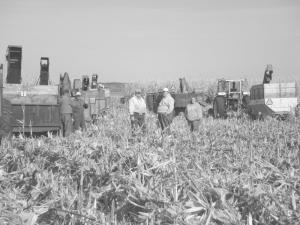2011 - Volume #35, Issue #1, Page #22
[ Sample Stories From This Issue | List of All Stories In This Issue | Print this story
| Read this issue]
Corn Picker Collecting Catches On Fast
 |
He is among a growing group of corn picker collectors who are interested in preserving their history. The last couple of years he check-planted a portion of his land with a modern planter to make it easier to harvest with corn pickers. That required adjusting planting equipment, lowering seed count/acre and reduced profits.
But it was worth it, Larkey says, referring to a photo of 23 pickers lined up in his field at a corn-picking event he sponsored. Including his collection there were 36 pickers altogether. The crew picked 90 acres of corn on a weekend in October.
"Corn pickers were the most important mechanical farm invention after threshing machines," Larkey says. The generation that remembers threshing machines is shrinking while there are still many who once used corn pickers from the 1950's to the mid 1970's. Because of that, corn picker collectors ù and corn picking events ù are on the rise.
"People want to be active with their toys," he jokes.
Larkey has used corn pickers all his life. He used them when farming with his grandfather and then again when he raised hogs, because he didn't have mold and fungus problems with ear corn. Some farmers still prefer ear corn, he notes. Others sell it for squirrel corn. And he has used corn pickers to harvest Indian corn.
Three years ago, a mix of insomnia and browsing on the internet led him into the world of collecting. He now has 16 Oliver pickers including three yellow ones that Oliver made for Minneapolis Moline. His most prized piece is a one-row picker/sheller with a bagging unit that Oliver reportedly made only a few of for Wisconsin researchers.
Larkey likes to collect both mounted and pull versions of the same Oliver models, and he has both shellers and huskers. At his corn-picking event, Larkey had mounted and pull-type pickers (including left-hand models), as well as two-row combines.
With a recent surge in scrap metal prices, many old pickers have been sold for scrap, and it can be difficult to find very old pickers in good working condition.
Prices for corn pickers Larkey has purchased vary from $200 to $1,700. They can be found on eBay and through collectible magazines and internet sites. Larkey notes that often wagons are more valuable than the pickers, anywhere from $100 to $3,000 if they're in good condition. One of his wagons has a wood box with original paint that he uses in parades.
As for holding a corn-picking event, he says to line up plenty of helpers and start planning early. He brought in an old wire corncrib to fill for display and had a 400-bushel wagon with sides. Besides corn pickers, some collectors brought commercial corn shellers, and Larkey lined up an elevator to take the corn after it was shelled and loaded in four semi trailers. A livestock feeder took care of the cobs and husks. The local Rotary organized the food and recruited vendors.
Bringing people to Walnut was important to Larkey, and with the success of his first two events, he plans to hold them every other year with the next in October 2012.
"Make sure you plant plenty of acres," he advises. Pickers had to pace themselves and work short days to stretch picking 90 acres over two days.
Contact: FARM SHOW Followup, Kevin Larkey, 14365-2850 N. Ave., Walnut, Ill. 61376 (ph 815 878-2524; jdmanlarkey@yahoo.com).

Click here to download page story appeared in.

Click here to read entire issue
To read the rest of this story, download this issue below or click here to register with your account number.




